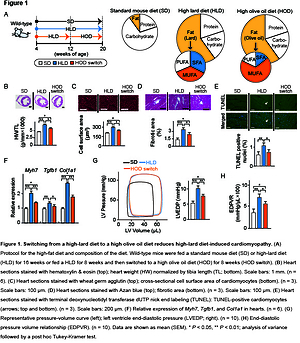Current issue
Archive
Manuscripts accepted
About the Journal
Editorial office
Editorial board
Section Editors
Abstracting and indexing
Subscription
Contact
Ethical standards and procedures
Most read articles
Instructions for authors
Article Processing Charge (APC)
Regulations of paying article processing charge (APC)
LIPID DISORDERS / RESEARCH PAPER
Saturated fatty acid-induced cardiomyopathy with diastolic dysfunction can be ameliorated by changing the quality of fatty acids to monounsaturated fatty acid
1
Department of Cardiology, Keio University School of Medicine, Japan
2
Graduate School of Pharmaceutical Sciences, Tokyo University, Japan
3
Department of General Medicine, Hyogo College of Medicine, Japan
Submission date: 2021-07-23
Final revision date: 2021-09-09
Acceptance date: 2021-09-20
Online publication date: 2021-10-10
Corresponding author
KEYWORDS
diastolic dysfunctionSIRT1saturated fatty acidsmonounsaturated fatty acidsstearoyl-CoA desaturase-1membrane fatty acid composition
TOPICS
ABSTRACT
Introduction:
Lipotoxicity due to obesity is known to lead to cardiac dysfunction. In an earlier study, we found that an increase in the ratio of saturated fatty acids (SFA) to monounsaturated fatty acids (MUFA) in the membrane of cardiomyocytes causes endoplasmic reticulum (ER) stress. Such stress is hypothesized to be involved in development of SFA-related cardiomyopathy. Another factor affecting the membrane SFA/MUFA ratio is suppression by SFA of SIRT1-mediated stearoyl-CoA desaturase-1 (SCD1), which is involved in converting SFA to MUFA. Therefore, we evaluated whether increasing dietary intake of MUFA can improve the membrane SFA/MUFA ratio.
Material and methods:
Wild-type mice (n = 30) and cardiomyocyte-specific SIRT1 knockout mice (n = 30) were randomly divided into 3 groups and assigned to 16 weeks of a standard mouse diet, 16 weeks of an SFA-rich high-lard diet (HLD), or 8 weeks of a HLD followed by 8 weeks of a MUFA-rich high olive oil diet (HOD switch).
Results:
Compared with the control group, the wild-type mice on the HOD diet showed normalized SIRT1-mediated SCD1 signaling, increased membrane SFA/MUFA ratio, decreased ER stress, and improved cardiomyopathy variables. The HLD-fed SIRT1 knockout mice showed greater changes in the SFA/MUFA ratio, ER stress, and cardiomyopathy variables than the wild-type mice. Switching from HLD to HOD ameliorated these phenotypes, although it did not restore the reduced expression of SCD1.
Conclusions:
The MUFA-rich diet was found to have a therapeutic effect on SFA-induced cardiomyopathy with diastolic dysfunction by directly rebalancing membrane fatty acid oversaturation and indirectly through the de-inhibition of SIRT1/SCD1 signaling.
Lipotoxicity due to obesity is known to lead to cardiac dysfunction. In an earlier study, we found that an increase in the ratio of saturated fatty acids (SFA) to monounsaturated fatty acids (MUFA) in the membrane of cardiomyocytes causes endoplasmic reticulum (ER) stress. Such stress is hypothesized to be involved in development of SFA-related cardiomyopathy. Another factor affecting the membrane SFA/MUFA ratio is suppression by SFA of SIRT1-mediated stearoyl-CoA desaturase-1 (SCD1), which is involved in converting SFA to MUFA. Therefore, we evaluated whether increasing dietary intake of MUFA can improve the membrane SFA/MUFA ratio.
Material and methods:
Wild-type mice (n = 30) and cardiomyocyte-specific SIRT1 knockout mice (n = 30) were randomly divided into 3 groups and assigned to 16 weeks of a standard mouse diet, 16 weeks of an SFA-rich high-lard diet (HLD), or 8 weeks of a HLD followed by 8 weeks of a MUFA-rich high olive oil diet (HOD switch).
Results:
Compared with the control group, the wild-type mice on the HOD diet showed normalized SIRT1-mediated SCD1 signaling, increased membrane SFA/MUFA ratio, decreased ER stress, and improved cardiomyopathy variables. The HLD-fed SIRT1 knockout mice showed greater changes in the SFA/MUFA ratio, ER stress, and cardiomyopathy variables than the wild-type mice. Switching from HLD to HOD ameliorated these phenotypes, although it did not restore the reduced expression of SCD1.
Conclusions:
The MUFA-rich diet was found to have a therapeutic effect on SFA-induced cardiomyopathy with diastolic dysfunction by directly rebalancing membrane fatty acid oversaturation and indirectly through the de-inhibition of SIRT1/SCD1 signaling.
Share
RELATED ARTICLE
We process personal data collected when visiting the website. The function of obtaining information about users and their behavior is carried out by voluntarily entered information in forms and saving cookies in end devices. Data, including cookies, are used to provide services, improve the user experience and to analyze the traffic in accordance with the Privacy policy. Data are also collected and processed by Google Analytics tool (more).
You can change cookies settings in your browser. Restricted use of cookies in the browser configuration may affect some functionalities of the website.
You can change cookies settings in your browser. Restricted use of cookies in the browser configuration may affect some functionalities of the website.



